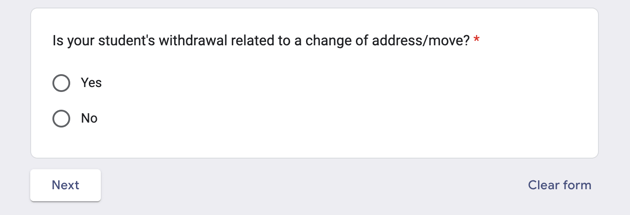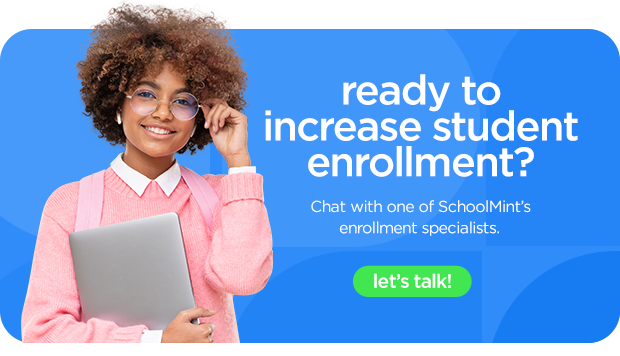The Power of Exit Interviews with Families: A School’s Secret to Improvement
In the world of school recruitment, you may be surprised to hear that it’s not just about welcoming new families; it can also be about saying goodbye thoughtfully.
Exit interviews with departing families might not be common practice in schools, but they can be a game-changer if done strategically. Remember that student retention is the foundation for strong student enrollment. Being very thoughtful with your retention efforts will decrease the need to over perform in recruitment.
Here’s why you should consider conducting family exit interviews plus a handy script you can use to create your own exit interview template — but before we get started, let’s make sure we’re on the same page!
What exactly IS a student exit interview?
An exit interview is a structured conversation or survey conducted by a school with families who have decided to withdraw their children from your school.
The primary purpose of an exit interview is to gather feedback and insights from departing families about their reasons for leaving the school as well as ensure they have the information they need to move forward.
So why should you consider an exit interview when families decide to move on? I’m glad you asked!
Below, I’ll outline the benefits of doing these interviews. The information you get can be invaluable to improving your student recruitment and retention strategies!
5 Reasons to Conduct Family Exit Interviews at Your School
1. Valuable Feedback
When a family decides to leave a school, they almost always have a clear reason behind their decision. Conducting exit interviews allows you to collect those reasons. This insight can be incredibly valuable in identifying areas for improvement.
Whether it’s curriculum concerns, communication issues, or anything else, exit interviews provide a direct line to understanding what went wrong and how you can improve in the future.
Take note of all feedback you receive, even if you don’t like it or don’t think it’s valid. Later on, you may start seeing patterns in what families are saying, and you can take action from there (more on this later).
2. Demonstrates Care
Conducting exit interviews sends a powerful message: you care about your students and their families, even when they’re leaving.
It shows that your commitment to improvement goes beyond retention rates. Families are more likely to have a positive perception of your school when they see you take their feedback seriously.
A family exit interview also gives you an opportunity to answer any lingering questions a parent may have:
- When and where should we return textbooks or technology?
- What happens to the unspent money in my child’s lunch account?
- How can I get my student’s transcript?
3. Identifying Patterns
Family exit interviews for schools help you gather lots of qualitative data, and over time, you should end up with lots of great insights. Find the patterns in this insight. You may identify commonalities in why families are leaving your school.
For example:
- Are there recurring issues?
- Are there systemic problems that need addressing?
- Are there issues disproportionately impacting families by race, ethnicity, socio-economic status, or family status?
By recognizing these patterns, schools can proactively make changes that benefit current and future students and families.
It may be helpful for you to organize this information into a spreadsheet, categorize the feedback based on primary concern(s), and take note of some basic family information, such as grade level. For example, if you notice you’re having an abnormally high level of fourth-grade families leaving due to reported bullying, you have something worth investigating further.
4. Continuous Improvement
Education is an ever-evolving field. You don’t see teachers teaching in the same way they did 50 years ago, because when we learn more, we do better.
Schools that engage in exit interviews demonstrate a commitment to continuous improvement. This proactive approach can lead to a positive cycle of growth, where feedback from departing families leads to changes that attract and retain new families.
5. Maintaining Relationships
Exit interviews are also an opportunity to leave the door open for future engagement. Families may return to your school if they see that their concerns were heard and addressed. Maintaining these relationships can have long-term benefits for both your school’s public perception and your student recruitment strategies.
How Should I Conduct Family Exit Interviews?
Now that you know that you know the benefits of an exit interview, let’s talk about the three most common ways to conduct them and examine which one might be right for your school.
Option 1: Email Survey
This is the easiest way to collect data and really doesn’t require much on-going effort from staff.
It’s easy to categorize responses and see data when you collect it in a standardized form (like a Google Form or through SurveyMonkey), but it lacks the personal touch and ability to ask follow-up questions or provide personal support for the family leaving your school.
If the biggest concern you have is time and the ability to easily implement a solution, a survey might be the way to go. It could be as simple as this (example; feel free to fill it out and see all the questions):
Option 2: In-Person
Let’s call out the elephant in the room here: in-person exit interviews can be really awkward — but there’s a reason they exist.
In-person interviews give you a good opportunity to engage in a conversation with the departing family and offer them specific and relevant support as they transition to their new school.
This gives the family a chance to ask questions related to next steps and also ensures the family feels heard by the school in a meaningful way.
You’ll need to keep good notes about your meeting in order to identify patterns and track data, but you’ll likely get more information in this type of conversation than a survey.
As a bonus — meeting the family at the school gives them an opportunity to turn in any technology and textbooks they might have as well as collect any items left in their student’s cubby or locker.
Conducting in-person exit interviews is harder to do, especially if emotions are running high as the parent is attempting to withdraw their child, but if done correctly, this might even allow you to “save” the relationship and keep the child enrolled.
Option 3: Virtually
When I worked in student recruitment, this was actually my favorite way to conduct an exit interview, so I’m a little biased.
Virtual exit interviews allow you to take away some of the intensity of meeting in person and also give both you and the family an easy way to end the conversation if it starts getting uncomfortable (which can happen but is unlikely in my experience).
You can record your call and watch it back if you need to for data capturing, and it still allows you to personalize your conversation in a way a survey just can’t.
Additionally, virtual interviews are a reasonable ask from former parents. Asking for them to physically come into the building during work hours is a big ask for working families, but taking 15 minutes to connect via Zoom or a phone call is a much smaller lift and still gets you the information you need!
So no matter how you do it, conducting exit interviews with departing families is a practice that benefits both schools and families. It provides valuable feedback, demonstrates a commitment to improvement, and helps maintain relationships.
By making this a part of your school’s process, you can create a culture of continuous growth and ensure that every family’s voice is heard and valued.
Script for a Virtual/In-Person Family Exit Interview
Start the meeting on a good note.
- DO: Thank the family for their willingness to help you out! Even if they had a bad experience, their feedback is valuable.
- DON’T: Use this time to hard-sell them into keeping their student at your school (unless it’s clear there is a “fixable” issue keeping them from continuing and they actually want to stay).
This is a time to listen and improve — not to convince families to give you another chance.
Here is an example of how that conversation may go:
Hi, Ms. Johnson. My name is Charli, and I’m the enrollment manager for Minty Middle School. Thank you so much for agreeing to meet with me!
I know you are withdrawing Jayden as of next Monday, and I thought we could use this time to make sure there are no lingering questions regarding the withdrawal process and also to learn a little bit more about your decisions and what your experience has been at Minty.
We’ll use this feedback to make changes and improve our school, and I promise to keep anything you’d like to be kept private confidential.
You’ll want to figure out the main reason a family is leaving. It can help to categorize these into major themes and later spot trends and patterns.
Questions to Ask in Your School Exit Interview
- What is the PRIMARY reason you chose to withdraw your student?
- What, if any, other factors impacted this decision?
- Is there anything the school could have done differently that might have made things better?
- Are there any outstanding questions or concerns you’d like to share with me at this point?
Next Steps
- Confirm their last day of attendance.
- Ensure any textbooks, materials, or technology are collected.
- Ensure the family knows how to request a transcript if needed. If you can have this ready before the meeting, that’s helpful.
- Ensure you have a good contact for any follow-up required.
- Ask where their student will be attending school next.
Thank the family for sharing — and, if appropriate, let them know you enjoyed having their student at your school and wish them the best.
Share this
You May Also Like
These Related Stories

What is Your School’s Brand Personality? [QUIZ]

How to Identify and Create Your School’s Brand





